PowerPoint 2016: Arrange and group objects
Align objects
When moving objects in PowerPoint, the tools used to align and adjust spacing appear as orange lines. Arrows are also placed around objects to help users align them. However, if there are many different objects on a slide, aligning everything perfectly can be a difficult and time-consuming task. Fortunately, PowerPoint provides a number of alignment commands, allowing users to easily arrange and position objects.
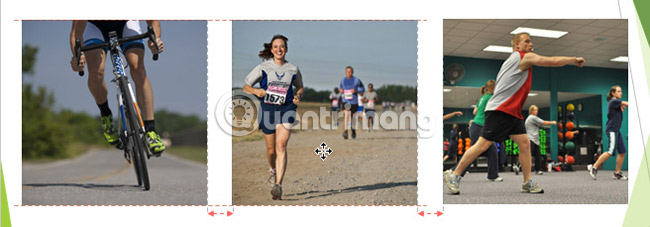
How to align two or more objects
1. Select the objects you want to align. To select multiple objects at once, hold down the Shift key while clicking. The Format tab will appear.
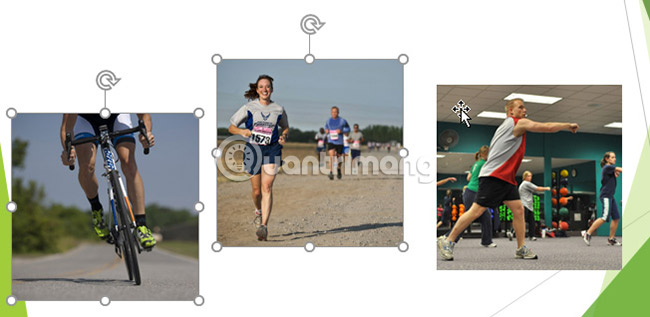
2. From the Format tab, click the Align command, then choose Align Selected Objects.

3. Click the Align command again, then choose one of the 6 alignment options.

4. The objects will align based on the selected option.

How to align objects for slides
Sometimes users may want to align one or more objects to a specific location in a slide, such as at the top or bottom. This can be done by selecting the Align to Slide option before aligning the objects.
1. Select the objects you want to align. To select multiple objects at once, hold down the Shift key while clicking.

2. From the Format tab, click the Align command, then select Align to Slide.

3. Click the Align command again, then choose one of the 6 alignment options.

4. The objects will align based on the selected option.

How to evenly space objects
After arranging objects in a row or column, users may want them to be equally spaced for a neater look. Users can do this by distributing objects horizontally or vertically.
1. Select the objects you want to align. To select multiple objects at once, hold down the Shift key while clicking.
2. From the Format tab, click the Align command, then choose Align to Slide or Align Selected Objects.

3. Click the Align command again, then choose Distribute Horizontally or Distribute Vertically from the drop-down menu that appears.

4. Objects will be evenly spaced.

Group of objects
You may want to group multiple objects into a group so they stay together if moved or resized. This is often easier than selecting each object each time you want to move it.
Images, shapes, clip art and text boxes can all be grouped. However, placeholders are not like that. If you want to group images, use one of the commands in the Images group on the Insert tab to insert the image instead of using the image icon inside the placeholder.

How to group objects
1. Select the objects you want to align. To select multiple objects at once, hold down the Shift key while clicking. The Format tab will appear.

2. From the Format tab, click the Group command, then select Group.

3. The selected objects will be grouped. An outline with resizing dots appears around the entire group to show that the objects are now a group. Now, users can move or resize all objects at once.

If you want to edit or move one of the objects in the group, double-click to select the object. It can then be edited or moved to the desired location.
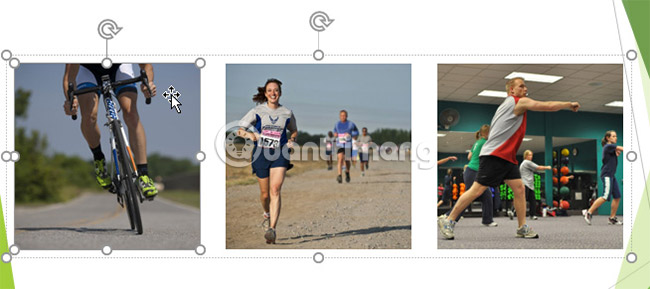
If after selecting objects the Group command is disabled, the reason may be that one of the objects is still in a separate placeholder. If this happens, try resetting the picture using the Pictures command on the Insert tab.

How to ungroup objects
1. Select the group of objects you want to cancel the group operation.
2. From the Format tab, click the Group command, then select Ungroup.

3. The objects will be separated from the group.

Arrange objects in order
In addition to aligning objects, PowerPoint also gives users the ability to arrange objects in a certain order. The order is important because it will determine which object comes before or after if there are 2 or more objects.
Learn the levels
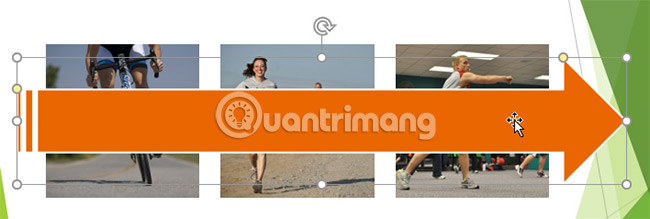
When objects are inserted into a slide, they are placed on levels, based on the order in which they were inserted into the slide. In the example in this article, an arrow is placed at the top level, but we can change the level to place it behind other objects.
How to change order by level
1. Select an object. The Format tab will appear.
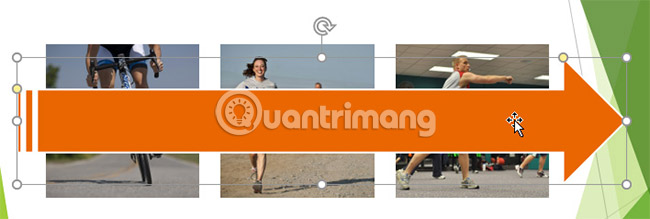
2. From the Format tab, click the Bring Forward or Send Backward command to change the order of objects by level. If there are multiple objects on the slide, it may be necessary to click the command multiple times to achieve the desired order.

3. The objects will be rearranged.

How to move an object forward or backward
If you want to move an object behind or in front of some other object, it is often faster to drag it forward or backward, rather than clicking the ordering commands multiple times.
1. Select the object.
2. From the Format tab, click the Bring Forward or Send Backward drop-down arrow.

3. From the drop-down menu, select Bring to Front or Send to Back.
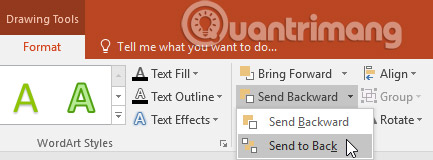
4. The objects will be rearranged.

If there are several objects placed on top of each other, it can be difficult to select an individual object. The Selection window allows users to easily drag an object to a new location. To access the Selection panel , click Selection Pane on the Format tab.

Rotate objects
If you need to rotate an object so it's facing a different direction, you can rotate it left or right or flip it horizontally or vertically.
How to rotate an object
1. Select an object. The Format tab will appear.

2. From the Format tab, click the Rotate command. A drop-down menu will appear.
3. Select the desired rotation option.
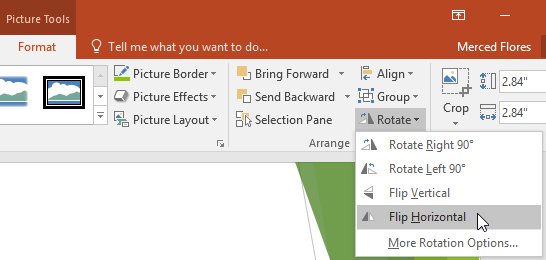
4. The object will rotate as desired.

Practice
1. Open the example practice presentation.
2. On the last slide, select the hamburger image and click Rotate Left 90° .
3. Hold down the Shift key and select all 3 food images. Make sure you don't choose green diamonds.
4. Select Align to Slide in the Align command, then click Align to Middle .
5. With the photos still selected, click Distribute Horizontally .
6. Select the first blue diamond and send it behind the breakfast photo.
7. When you're done, your slide will look like this:

Wish you success!
 6 reasons to use an external webcam
6 reasons to use an external webcam Windows 11 is about to offer better control over HDR features
Windows 11 is about to offer better control over HDR features Google's advanced AI image creation tool officially launches
Google's advanced AI image creation tool officially launches Instagram will test a vertical profile grid
Instagram will test a vertical profile grid Microsoft updates a series of useful new features for Windows Sandbox
Microsoft updates a series of useful new features for Windows Sandbox PowerPoint 2016: How to insert videos into PowerPoint
PowerPoint 2016: How to insert videos into PowerPoint